Functions, Food Sources, Symptoms of deficiency - Classification of Vitamins | 11th Nutrition and Dietetics : Chapter 11 : Vitamins, Minerals and Water
Chapter: 11th Nutrition and Dietetics : Chapter 11 : Vitamins, Minerals and Water
Classification of Vitamins
Classification
of Vitamins
Vitamins differ from
each other in physiological function, chemical structure, and distribution
foods. Plants synthesize all vitamins they require and therefore vegetables and
fruits are rich sources of vitamins. They are broadly divided into two
categories, on the basis of solubility in fats or water.
Fat Soluble Vitamins
Fat – soluble vitamins
are soluble in fats and fat solvents. They are insoluble in water. So these
vitamins are utilized only if there is enough fat in the body.
1. Vitamin A
Vitamin A was discovered in 1909 and its chemical name is retinol. The vitamin A compounds include retinol, retinal and retinoic acid. It has a specific function in the retina of the eye. Vitamin A occurs only in foods of animal origin. Vitamin A activity is possessed by carotenoids found in plants. Hence carotenoids are called provitamin A.
Functions
· It provides the required stimulation for vision in the retina and is essential for maintaining normal vision.
·
It helps in maintaining healthy skin and epithelial tissues.
·
It is important for proper growth of bones.
·
It helps in normal foetus development.
·
It protects the mucous membrane of the digestive, respiratory
and urinary tracts against infection.
Food Sources of Vitamin A
Vitamin A is present
as retinol in animal sources such as egg yolk, fish (halibut, shark, cod),
liver and cod liver oils. In plants, it is found in the form of carotene which
gets converted to vitamin A in the body. Carrot, beetroot, turnip, papaya,
mango, pumpkin, tomatoes, green leafy vegetables, drumsticks, whole milk,
butter, ghee etc., are very good sources of carotene.
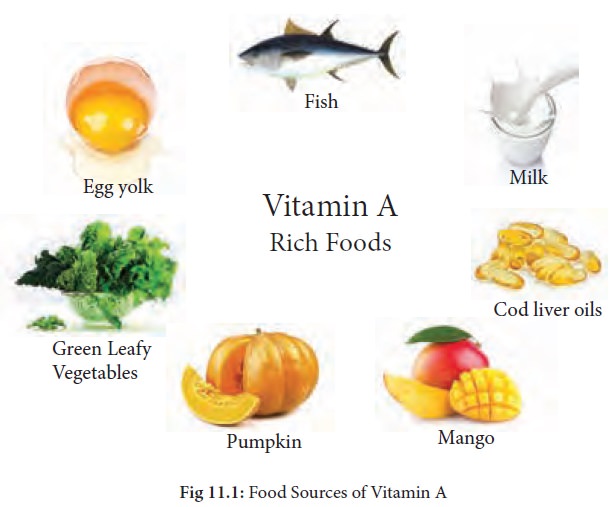
Symptoms of Vitamin A deficiency
1. Night blindness: This is also called as
Nyctalopia. Initially there is itching, burning and inflammation of eyelids and
the person gradually loses vision to see in the dim light.
2. Keratomalacia: This occurs due to
poor intake or poor absorption of vitamin A. When conjunctival xerosis is not
treated it may develop into a condition known as keratomalacia. Cornea becomes
dull.
3. Xeropthalmia: This occurs in which
the eyes become thickened, wrinkled and extremely dry followed by progressive
cloudiness. This is due to keratinisation of the epithelial cells over the
cornea. This condition is extremely common among all age groups in India and
other developing
4. Bitot’s spot: Silver grey foamy
deposits on the delicate membranes covering the whites of the eyes. Softening
of the corneas may lead to corneal infection, perforation and degenerative
tissue changes, which may result in blindness.
5. Skin becomes rough,
dry and scaly. This condition is known as toad’s skin.
2. Vitamin D
Vitamin D is otherwise
known as ‘sunshine vitamin’ as it can be synthesized from sunlight by our body.
Hence, vitamin D requirements of Indians are considered to be met entirely by
exposure to sunlight. In the absence of exposure to sunlight a daily
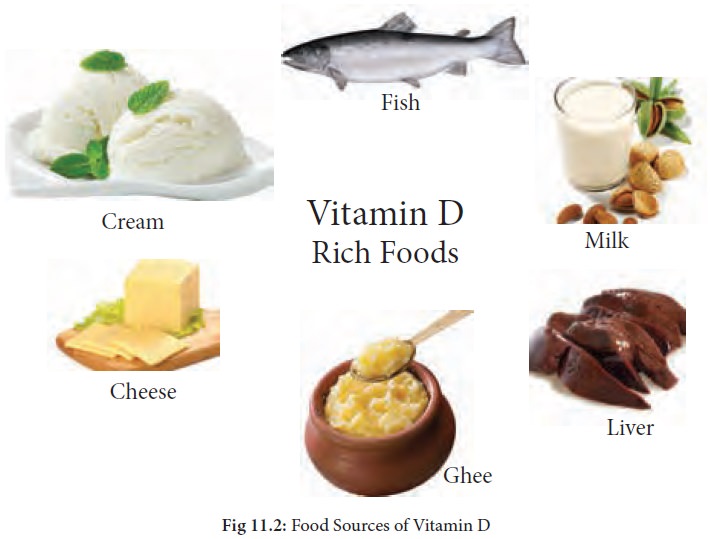
Vitamin D is produced under the skin after exposure to
ultraviolet rays. Vitamin D is now considered as a pro hormone rather than a
vitamin and is required for Calcium absorption and bone formation.
Functions
·
It helps in the formation of bones and teeth.
·
It also improves the calcification of bones.
· It helps to increase the absorption of calcium and phosphorus.
·
It helps in increase of citrate content in bones and blood.
Food Sources of Vitamin D:
Sunlight: Exposure of skin to
sunlight brings about synthesis of vitamin D from 7 dehydrocholesterol.
Food products: Cod liver oil, liver,
salmon and herring fish, fortified milk, egg yolk, butter, cheese, ghee, cream,
fortified milk, etc., are the best sources of Vitamin D.
Symptoms of Vitamin D deficiency:
Symptoms in children Rickets:
When children’s bodies
don’t get enough vitamin D, they cannot absorb enough calcium and phosphorus to
mineralize and harden the bones and teeth. If calcium and phosphorus are
not deposited enough to
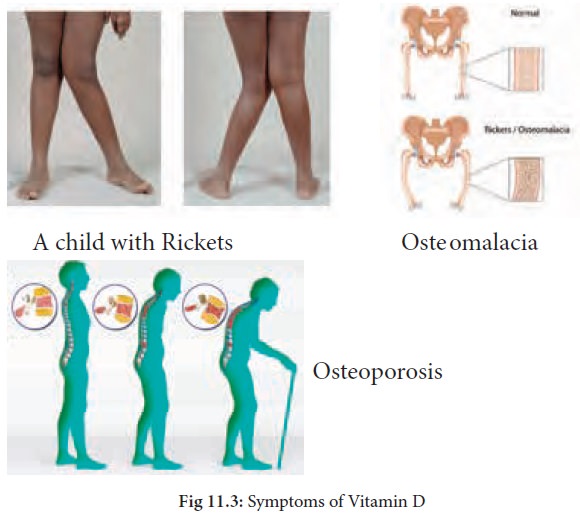
Their bones become too
weak to support their weight and their legs bow under the pressure and may
exhibit the following symptoms:
·
Bow legs (legs bow outwards).
·
Knock-knock knees (legs bow inwards with knees touching each
other).
·
Enlarged joints (The ends of long bones enlarge), Pigeon’s Chest
(ribs become hollow and bulge out).
·
Their teeth will become soft and irregular shaped.
·
Head becomes abnormally large and square shaped with bulging
sides.
Symptoms in Adults:
Osteomalacia:
·
Adults get osteomalacia. In this disease, the bones become soft,
fragile and easily bendable and are more prone to multiple fractures.
·
Cramps are common.
·
Spinal cord, thorax, limbs and pelvis may be deformed and back
may be hunched. Person may suffer from lower back pain.
Symptoms in Oldage
Osteoporosis: It is a calcium related health problem and occurs frequently in old people.
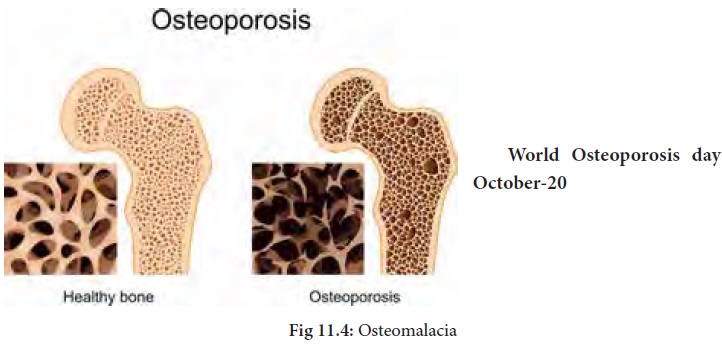
This disease is characterized by having light porous
and spongy bones that break very easily. Severe bone pain is
reported which is relieved by immobilization. Fractures occur due to brittle bones
which heal off normally.
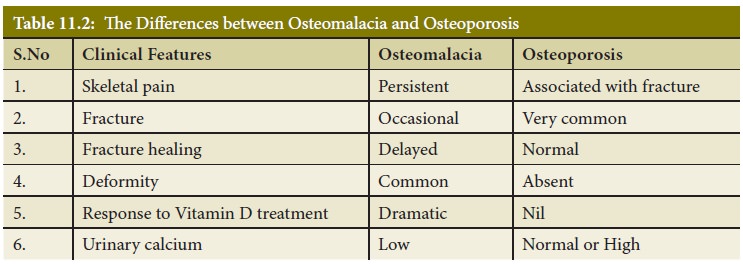
3. Vitamin E
Vitamin E protects
cell membranes and other fat-soluble parts of the body. They are called as
tocopherol. This word is derived from ‘tocos’ meaning child birth, and ‘phenos’
meaning to bear and ‘ol’ means alcohol. The vitamin is stored in all the tissues
and the tissue stores can provide protection against the deficiency for long
periods.
Functions
·
Vitamin E is an important antioxidant
·
Promotes normal growth
and development
· Promotes normal red blood cell formation
·
Acts as anti blood clotting agent
·
helps in absorption of vitamin A and vitamin C.
·
Vitamin E dilates the capillaries and enables the blood to flow
freely into blood deficient muscle tissue, thus strengthening both the tissues
and the nerves supplying them.
·
reduces the risk of heart diseases
Food Sources of Vitamin E
The principle source
of vitamin E in diet is vegetable oils - Corn, and peanut oil. Nuts and seeds -
Almonds, hazelnuts, sunflower seeds, saffiower, soya bean oils, walnuts,
margarine, meat and fish, whole grains, wheat germ, spinach, lettuce, dark
green leafy vegetables, black berries, apple, pears, legumes, eggs and milk are
good sources of vitamin E. Human milk has more vitamin E than cow’s milk and is
sufficient for infants.
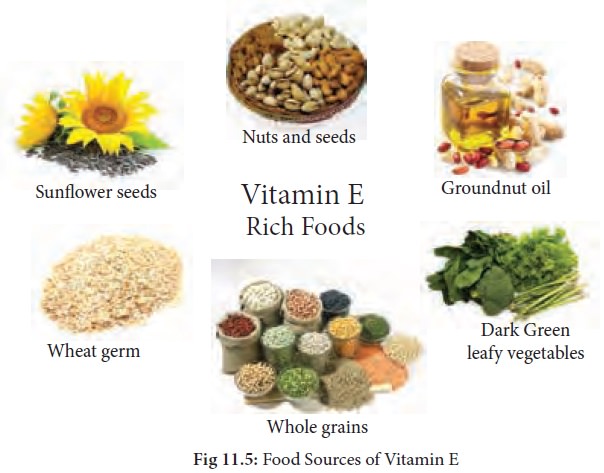
Symptoms of Vitamin E deficiency
·
Anaemia in premature infants.
·
Increased risk of oxidative damage to body tissues.
·
Vitamin E deficiency may lead to heart and lung disease and
brain stroke.
·
Frequent blood clots may occur which in turn play a role in the
production of varicose veins.
4. Vitamin K
Vitamin K is called
coagulation vitamin. It is essential for the production of a type of protein
called prothrombin and other factors involved in the blood- clotting mechanism.
Prothrombin levels in the blood determine the rate at which the blood will
clot. For blood to clot, fibrinogen a soluble protein must be converted into
fibrin. Thrombin catalyses the proteolysis of fibrinogen to yield fibrin.
Functions
·
Helps in clotting of blood.
·
Participates in bone formation and
remodeling(synthesisofosteocalcin).
·
It isnecessary for theformation obone matrix and mineral
deposition.
·
Vitamin K is essential for the prevention of internal bleeding
and haemorrhages.
·
It is important for the normal functioning of the liver.
·
It is involved in energy producing activities of the tissues and
nervous system.
Food Sources of Vitamin K
The concentration of
vitamin K in foods is highest in dark green leafy vegetables, especially
spinach. It is also found in soyabean, yoghurt, wheat, oats, milk, meat,
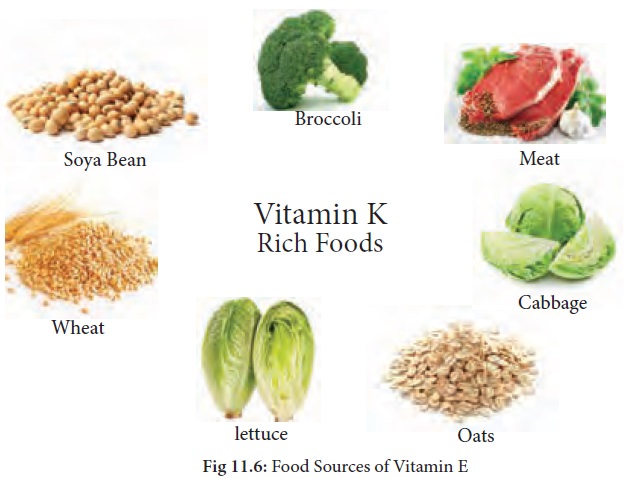
Symptoms of Vitamin K deficiency
·
Leads to increased
tendency
to hemorrhages.
·
Defective blood clotting.
·
Bleeding occurs in nose.
·
Prothrombin levels are reduced.

Water Soluble Vitamins
Water soluble vitamins
are soluble in water and so they cannot be stored in the body. Therefore, a
day-to-day supply of these vitamins is essential.
The B vitamins have
important metabolic roles as coenzyme partners with cell enzymes that control
energy metabolism and build tissue. Eight vitamins are there in this group.
1. Vitamin B1 (Thiamine)
Thiamine
acts as a catalyst in the oxidation process which prepares glucose in the body to provide
energy. Vitamin B1 is a vital coenzyme which changes the three sources of energy – fats, carbohydrates and
proteins into energy (glucose). So, without B1 the body cannot use
the food to make energy. It is known as ‘Appetite vitamin’ and makes a person
feel hungry.
Functions:
·
Thiamine helps increase
hunger. Thus aids
normal growth.
·
Thiamine controls mental andnervous fatigue, irritability and
restlessness.
·
Promotes growth, protects the heart muscle and stimulates brain
action.
·
The vitamin improves peristalsis and helps to prevent
constipation.
·
Improves circulation of blood and promotes a healthy skin.
Food Sources of Thiamine
Whole grain cereals,
wheat, rice, oats, yeast, sunflower seeds, peanuts, Bengal gram, capsicum,
turnip, beet, fish, liver, legumes, nuts, wheat germ, baked beans, whole grains
enriched breads and cereals, egg etc.,
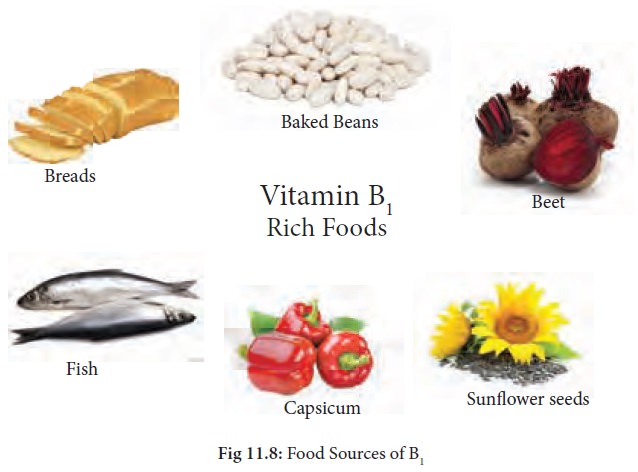
Symptoms of thiamine deficiency
·
Loss of appetite, poor digestion.
·
Muscular weakness and feeling tired
·
Insomnia, mental depression,
·
Loss of weight, leg cramps
·
Digestive disorder
·
Slow heart beat and
·
Gastrointestinal problems
Deficiency Diseases
Thiamine deficiency causes beriberi and there are three kinds of Beriberi
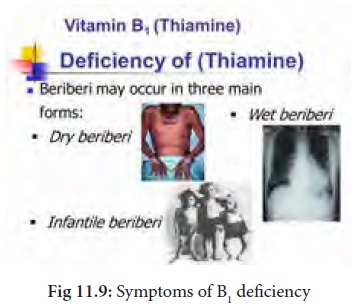
1. Dry Beriberi affects the nervous
system, tingling and loss of sensation which may cause limb paralysis and
degeneration of nervous tissues. There is difficulty in walking, foot and wrist
drop.
2. Wet Beriberi affects the heart.
There is difficulty in breathing. It enlarges the heart causing painful
palpitations, disfunctioning of heart and heart attack.
3. Infantile Beri occurs mostly in
infants who cry without sound. Infants has difficulty in breathing, body turn
blue and may die within 24-28 hrs.
It also leads to poor
functioning of gastrointestinal tract and poor appetite.
2. Vitamin B2 (Riboflavin)
Riboflavin is water
soluble and relatively
heat stable. It is
easily absorbed from the intestine and the excess is excreted through urine. It
is essential for the health of skin and for normal vision.
Functions
· Riboflavin plays an important role in the health of the eyes and alleviates eye strain and is essential for proper vision and healthy sight.
·
Riboflavin assists production of Red blood cells (RBC).
·
It strengthens mucous
lining
of mouth, lips and
tongue.
·
It is required for normal growth and wound healing.
·
Riboflavin is needed in every cell of the body. It helps cells
to use
·
oxygen so that the body can convert sources of energy into
glucose.
Food Sources of Riboflavin:
Yeast, milk, curd,
cheese, eggs, chicken, liver, pork, spinach, carrot leaves, beets, brown rice,
sprouts, beans, Fruits like Apricots, papaya, custard apple. Nuts like Almond
and walnut are rich sources of riboflavin. Large amounts are found in dairy
products, eggs and meats. Green leafy vegetables and enriched grains are
moderate sources of Riboflavin.

Symptoms of Riboflavin deficiency
·
Cracks and redness at corners of mouth – Cheilosis.
·
Painful, smooth, purplish red tongue - Glossitis.
·
Sore throat.
·
Inflamed eyes and eyelids, sensitivity to light.
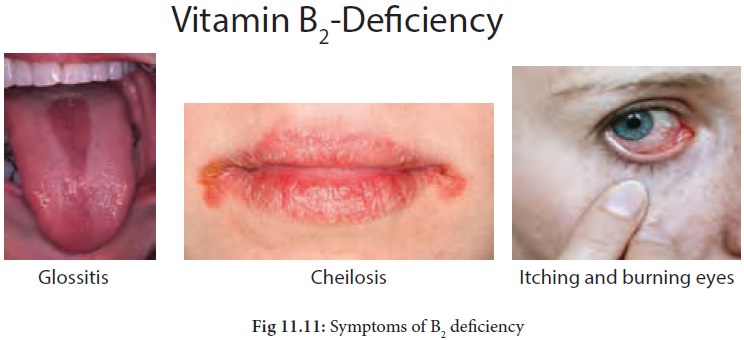
·
Itching and burning eyes.
·
Intolerance to bright
light,
dim vision, water in
eyes.
·
Skin rashes and
·
Digestive disturbances.
3. Vitamin B3 (Niacin)
Niacin is a water
soluble vitamin which is also known as vitamin PP (pellagra preventive factor)
Niacin exists in two forms: nicotinic acid and nicotinamide.
Functions
·
Important for proper blood circulation and healthy functioning
of the nervous system.
·
Promotes the health of digestive track.
· It repairs DNA.
·
It regulates blood sugar levels.
·
It lowers cholesterol levels.
·
It is essential for normal functioning of skin and nerve system.
Food Sources of Niacin
Liver, chicken, meats,
prawns, fish, legumes, cereal, mushroom, peanuts, green leafy vegetables,
broccoli, dates, peas, groundnuts, almonds, sunflower seeds, avocado are rich
in Niacin.

Symptoms of Niacin deficiency
·
A mild deficiency of niacin may result in a coated tongue, sores
in the mouth, irritability, nervousness, skin lesions, diarrhoea,
forgetfulness, insomnia and headache.
·
Pellegra - Niacin deficiency leads to Pellagra-a disease of 3D’s-
dermatitis, diarrhoea and dementia
followed by death (if not treated).
·
Dermatitis - This includes rough, scaly pigmented skin with rash
on skin exposed to sunlight. Swollen mouth on skin exposed to sunlight.
·
Diarrhoea - loose stools and vomiting.
·
Dementia - nerve damage, numbness in limbs, tingling in hands
and feet. Poor muscle coordination, disorientation and loss of memory.
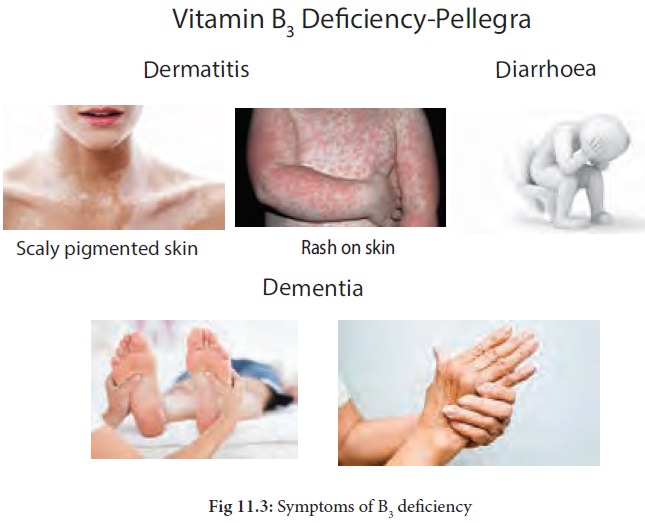
4. Vitamin B6 (Pyridoxine)
Pyridoxine is a colourless compound soluble in water and alcohol. It is well absorbed in the upper segment of the small intestine. It is stored in muscle but found in tissues throughout the body.
Functions
Production of red
blood cells.
·
It is readily absorbed from intestines.
·
Improves immunity.
·
Improves nervous system functions.
·
Reduce muscle spasms, cramps and numbness.
·
Maintains proper balance of sodium and phosphorous in the body.
Food sources of
Pyridoxine: Good food sources include whole grains, legumes, bananas, potato,
liver, kidney and other meats, fortified breads and cereals. Sunflower seeds,
soya beans, walnuts and yeast are the richest sources of pyridoxine among plant
foods.
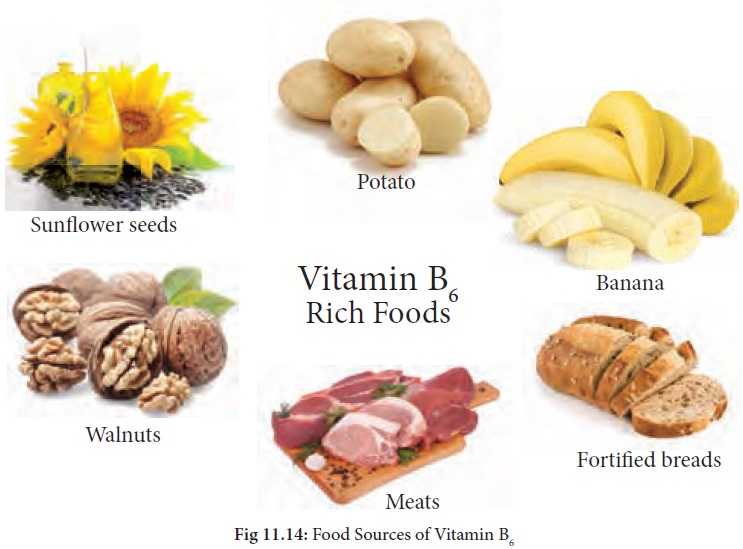
Symptoms of Pyridoxine deficiency
·
Nervousness, Insomnia, Anaemia, oedema,
mental depression.
·
Loss of muscle
control,
muscle weakness, tooth
decay.
·
Arm and leg cramps,
·
Water retention,
·
Skin lesions and skin disorder.
5. Vitamin B9 (Folic Acid)
Vitamin B9 includes
both folate and folic acid and is important for several functions
in the body. It is
important for women who are pregnant to consume enough folic acid.
Functions of folic acid: The different functions of folate include:
·
Folic acid helps the body to convert carbohydrates into glucose,
which is used to provide energy.
·
Folic acid helps in building of antibodies which prevent and
heal infections.
·
It helps in normal functioning of the nervous system and
maintains the mental and emotional health.
·
It helps in production of body’s generic material - DNA and RNA.
Food sources of Folic
acid: The
rich sources of folate are fish, mutton, liver, egg, chicken, green leafy
vegetables, pulses, Lentils, beans, asparagus, lettuce, Parsley, avocado,
sunflower seeds, beets, broccoli, spinach, orange juice, tofu, fish, meat, fortified cereals, milk, cheese, eggs,
oysters, crab etc.,
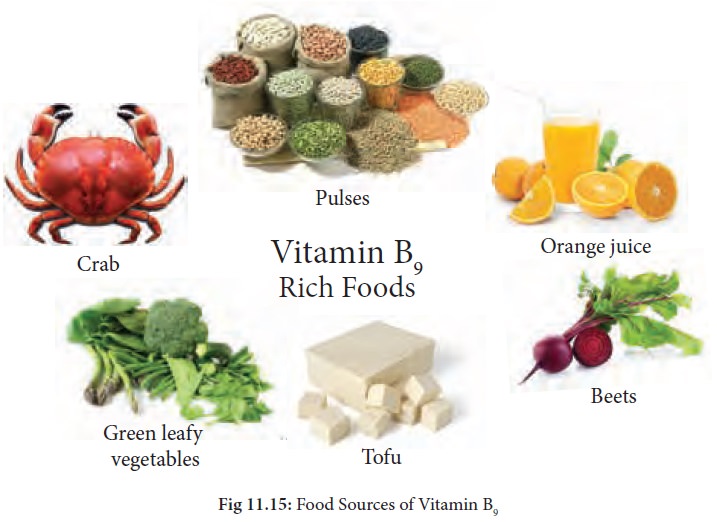
Symptoms of folic acid deficiency
·
A recent study connected folic acid deficiency with autism.
·
Loss of memory, severe and irreversible damage to nervous system
and brain.
·
Pernicious anaemia which is an immune system disease.
·
Deficiency of folic acid causes megaloblastic anaemia.
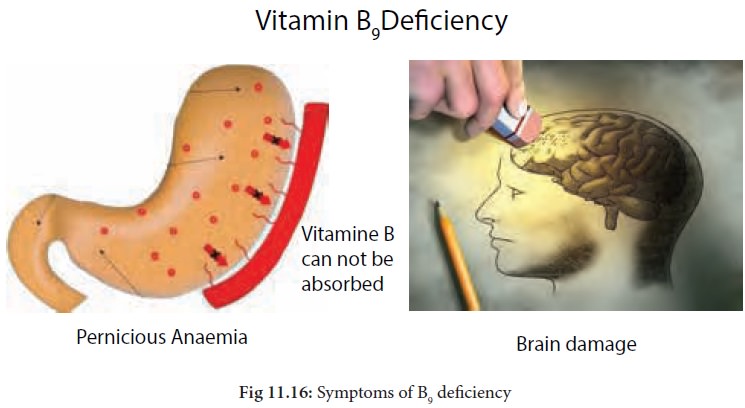
6. Vitamin B12 (Cyanocobalamin)
Thevitaminisnamedascyanocobalamin
because of the presence of cobalt and cyanide in its structure. It can be absorbed in the body only in the presence of intrinsic factor (IF).
Functions
·
It is essential for the production and regeneration of red blood
cells.
·
It improves concentration, memory and balance.
·
It synthesises and regulates DNA.
·
It plays an important role in normal functioning of brain and
nervous system.
·
It also helps to absorb folic acid.
Food Sources of Cyanocobalamin
Cyanocobalamin is
synthesized by bacteria and is found in foods of animal origin. Liver is the
richest source of cyanocobalamin. Meat, chicken, oysters, eggs, fish, milk,
curd, cheese are good sources of Vitamin B12.
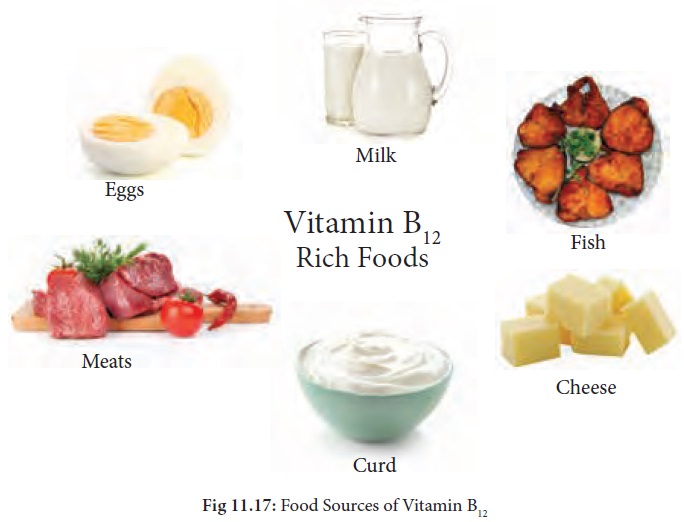
Symptoms of Cyanocobalamin deficiency:
·
Loss of memory
·
Fatigue
·
Anemia
·
Severe and irreversible damage to the nervous system and brain
· Pernicious anaemia is caused due to its deficiency in the body which is an immune system disease.
7. Vitamin C
Vitamin C is also
known as ascorbic
acid. It is an
antioxidant and water soluble vitamin. It is destroyed by light, heat and when
exposed to air and metals. During cooking much of it is destroyed. Iron and
copper act as catalysts and cooking in these vessels increases the loss of
vitamin C. When the vegetables are cut into fine pieces more enzymes is
released and it causes more loss. Vitamin C is essential in cholesterol
metabolism.
Functions
·
It is helpful in the formation of collagen the cementing
material between cells that holds them together.
·
Vitamin C builds up natural body defence and helps provide
immunity to the body.
·
It helps the body to absorb more iron from plant sources.
·
It aids in the healing of wounds.
·
It helps to keep gums healthy.
·
It helps body to fight infections.
·
Improves bone formation.
·
It prevents the deposition of cholesterol on the walls of the
arteries and prevent heart diseases.
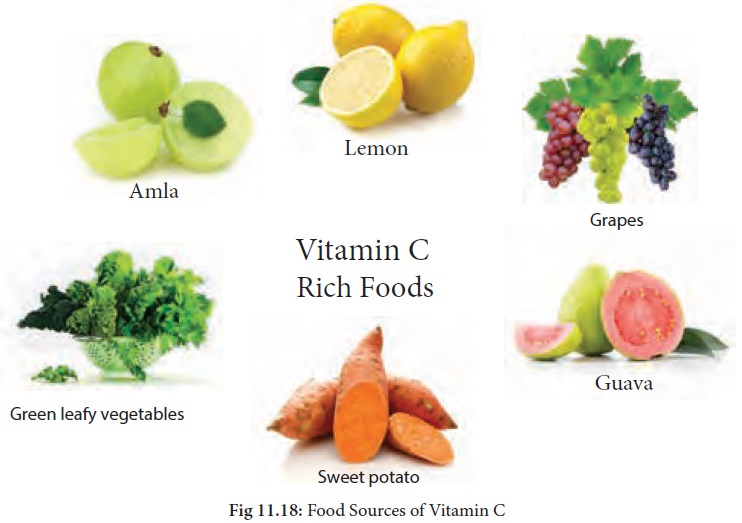
Food Sources of
Vitamin C: Amla, kiwi, strawberry, raspberry, grapes, berries, guava,
citrus fruits like sweet lime, lemon, oranges, green leafy vegetables, spinach,
hot chillies, turnip greens, broccoli, red bell pepper, tomato juice, raw
tomato, sweet potato etc.,
Symptoms of Vitamin C deficiency
·
Gums swell and bleed and become purple and spongy. This is known
as pyorrhoea. Foul smell emits from the mouth.
·
Deficiency can lead to scurvy in which a slight injury produces
excessive bleeding and large hemorrhages are seen under the skin.
·
There is tenderness, swelling and pain in the limbs.
·
Reduced immunity causes simple infections like common cold, flu-
viral, etc.,
·
Irritability, aneamia, poor
wound healing and
Diarrhoea.
·
Gastrointestinal discomfort.
·
Weight loss, fatigue and joint pain.
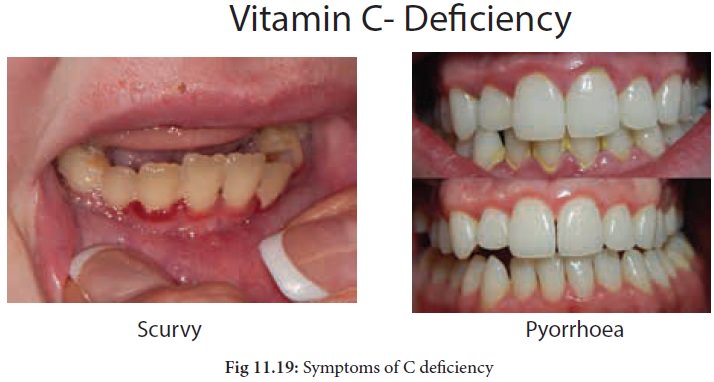
Related Topics